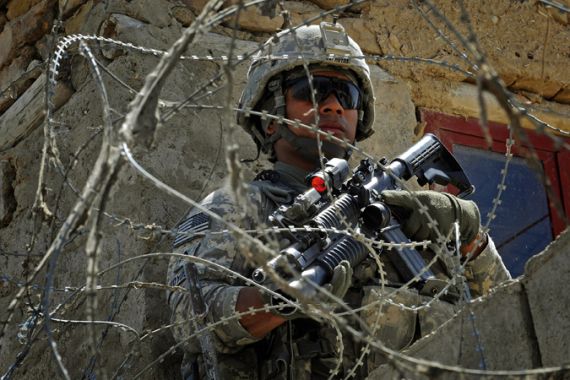Nine NATO troops killed in Afghanistan
Two Afghan policemen also died in the explosions in the mountainous Shorabak district of Kandahar province.

 |
| The Taliban claim responsibility for the blasts [GALLO/GETTY] |
Nine NATO soldiers have been killed in Afghanistan, eight of whom died in two successive roadside bomb explosions in a field where they were on foot patrol, officials said.
Two Afghan policemen also died and two others were wounded in the explosions in the mountainous Shorabak district of Kandahar province, 19km from the Pakistan border, on Thursday, said General Abdul Raziq, chief of the Afghan border police in the province.
“Two months ago, we cleared this area of terrorists, but still they are active there,” Raziq said.
The Taliban, speaking through its spokesman Qari Yousef Ahmadi, claimed responsibility for the blasts.
A US official, speaking on condition of anonymity because he was not authorised to disclose the information, confirmed that eight US service members died in the bombing. NATO said another soldier was also killed in a helicopter crash in the east, but his nationality was not immediately released.
It was the deadliest day for coalition forces in Afghanistan since April 27, when a veteran Afghan military pilot opened fire at Kabul airport and killed eight soldiers and a civilian contractor.
Defence officials attributed the rise in casualties to the surge in US forces in Afghanistan last year. The number of US troops wounded by what the military terms ‘improvised explosive devices’ also soared, according to the most recent US defence figures.
The war in Afghanistan is currently costing the US Treasury more than $100bn a year.
Last year, the Pentagon spent $495 million to buy 34 tethered surveillance blimps that give troops a bird’s eye view of certain areas and sent in more unmanned surveillance aircraft so route-clearance patrols would have the benefit of full-motion video.
Withdrawal implications
Southern and eastern Afghanistan are seen as the most volatile areas in Afghanistan where tens of thousands of US-led NATO and Afghan forces have been working for months to oust the Taliban from their strongholds in the south.
The Taliban have retaliated with targeted assassinations of Afghan officials and reprisals on Afghan and coalition forces.
Eastern Afghanistan, along the Pakistan border, has also been the scene of heavy violence.
On May 1, insurgents declared the start of a spring offensive against NATO and the Afghan government.
NATO has been expecting the Taliban to stage a series of spectacular and complex attacks, and the group has already carried out a number of them recently.
The effectiveness of the Taliban’s long-awaited spring campaign, code-named Badr, could affect the size of president Barack Obama’s planned drawdown of US troops in July.
General David Petraeus, the top US and NATO commander in Afghanistan, has said the size of the withdrawal will depend on conditions on the ground.
The alliance has committed itself to handing over control of security in the country to Afghans by 2014.